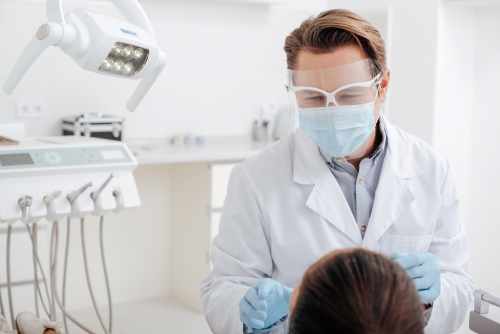Enter your email to receive the CareQuest newsletter:
April 19, 2023
Tooth decay is often cited as the most common disease that can threaten a person’s oral health and overall health. It’s true, but it’s certainly not the only threat.
The most common sexually transmitted infection in the US, human papillomavirus (HPV), also poses a serious risk.
HPV causes a majority of mouth and throat cancers. These oral cancers are on the rise and can be life-threatening — something worth noting at any dental appointment but especially during Oral Cancer Awareness Month in April.
Fortunately, a vaccine exists that prevents more than 90% of the six types of cancer that HPV triggers, including oral cancer.
Both primary care and dental providers can play a crucial role in raising patients’ awareness about the HPV vaccine and its relationship to mouth and throat cancers. Clinicians can also save lives by actively screening for oral cancer, which does not always have obvious symptoms.
Recent Research: Who Is at Risk for Oral Cancer?
A recent study coauthored by CareQuest Institute researchers shows a connection between oral cancer rates and certain forms of insurance. It compares cancer cases among adults who hold private coverage to their peers enrolled in Medicaid, an insurance program for people with low incomes.
It’s among the few reports to examine what a broad set of health coverage data can tell us about the threat of oral cancer across communities.
This research spotlights that economic inequities continue to drive many oral health disparities, including in oral cancer:
- People enrolled in Medicaid have higher levels of mouth and throat cancer overall and face more new diagnoses than their privately insured peers.
- Compared to those with private coverage, adults enrolled in Medicaid are more likely to be diagnosed with oral cancer at advanced stages and to die from the disease.
- Getting regular dental care can help. People who saw a dentist in the past year were less likely to have oral cancer than those who had not visited a provider.
Not every state’s Medicaid program includes dental benefits for adults. Lacking coverage can push oral health care out of the reach of many people with low incomes. Researchers note that this limited access may be one reason why adults enrolled in Medicaid shoulder a greater burden of disease.
In addition to the harm posed by financial and policy barriers, oral cancer has other risk factors:
- Men are more often diagnosed with mouth or throat cancer than women.
- The threat of oral cancer increases with age and tobacco use.
- Using e-cigarettes, or vaping, also heightens the risk of developing oral cancer. In 2020, more than nine million adults used vaping products.
Evidence is also clear that HPV is a danger. It causes 7 in 10 cases of mouth and throat cancer, which are largely preventable with the HPV vaccine.
Health Providers Play a Pivotal Role in Oral Cancer Screenings
People with oral cancer may not have noticeable symptoms, as the disease can lurk in hidden areas of the tongue and mouth.

Primary care providers can detect early signs of disease by performing regular oral cancer screenings. According to Mark Deutchman, MD, a family medicine physician and professor at the University of Colorado, taking a proactive approach is key.
“Unless we actively look,” he explains in a CareQuest Institute video, “we’ll miss it.”
Providing an oral cancer screening during a medical appointment is easy and quick. Deutchman says it “takes literally seconds and could go a long way toward finding these things earlier.”
Dental providers also have an important role. They can search for physical symptoms during oral exams.
In addition, dentists and dental hygienists can raise patients’ awareness about how HPV can cause oral cancer.
Research affirms that oral health providers can be a trusted source on this topic. According to a national CareQuest Institute survey, nearly 6 in 10 adults say they are comfortable discussing HPV and its vaccine with their oral health provider. However, many parents and young people don’t know about the link between HPV and oral cancer.
Dental and medical providers can save lives by opening the conversation.
Helping to Prevent Oral Cancer
HPV-related oral cancer can develop decades after someone has contracted the virus. People are more often diagnosed after 40 years old. The National Institute of Dental and Craniofacial Research emphasizes that oral cancer “can spread quickly,” so prevention and early detection are critical.
For the greatest protection across our lives, health experts recommend that people get the HPV vaccine starting at age 11 or 12. Young people can receive the two-dose vaccine through age 26.
However, due to the COVID-19 pandemic, youth immunizations have dropped nationwide. About half of all teens are behind in getting their HPV vaccine, and now they’re at greater risk of getting oral cancer later in life.
Dentists, dental hygienists, and others on the oral health care team can help close the gap. CareQuest Institute data show they have an important opportunity to promote prevention by talking to young people and their caregivers:
- Among youth who visited a dentist over the past year, but are not vaccinated against HPV, 12.5% of them had not seen a medical provider during the same period.
- Young people who had a dental appointment in the past year are more likely to have received the HPV vaccine.
Receiving both doses of the HPV vaccine can prevent more than 9 in 10 cases of all six forms of cancer caused by the virus. By discussing this core preventive measure with their patients, medical and dental providers can take the lead on reducing the harm of oral cancer.